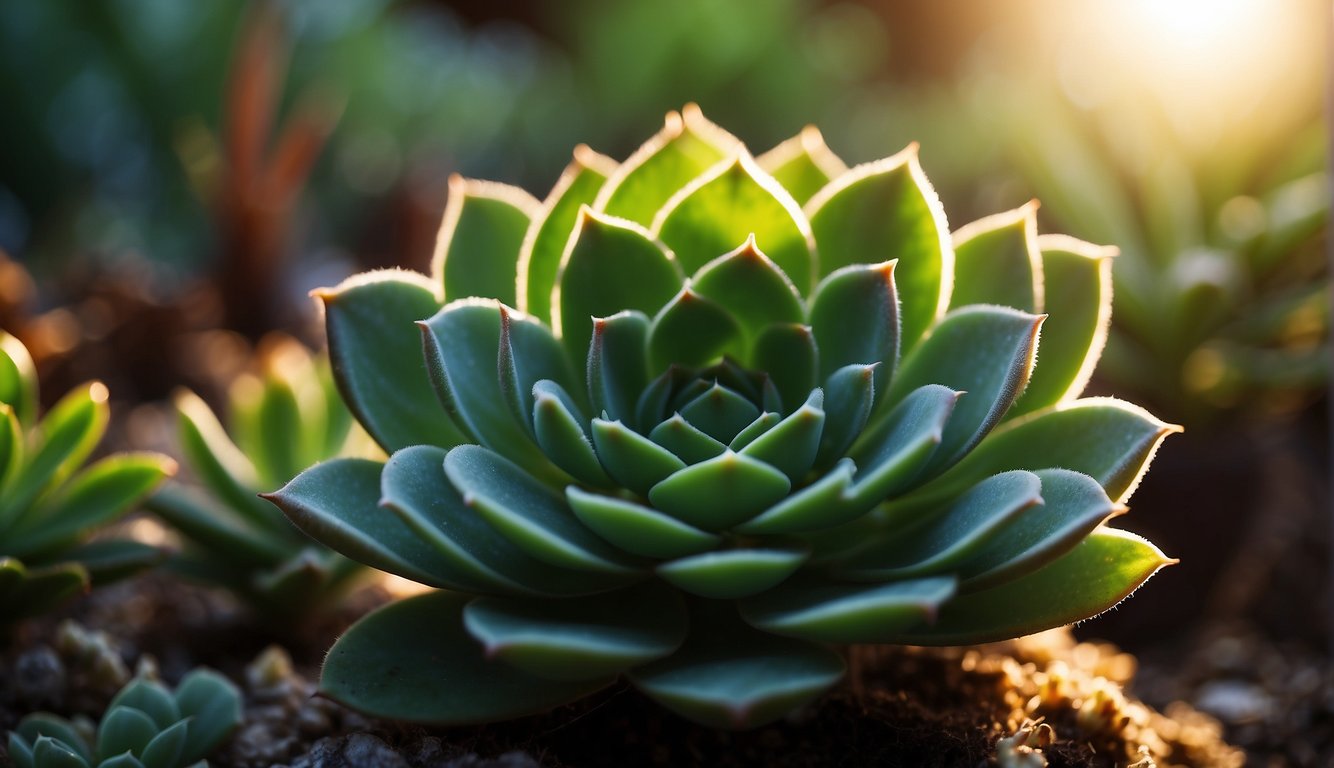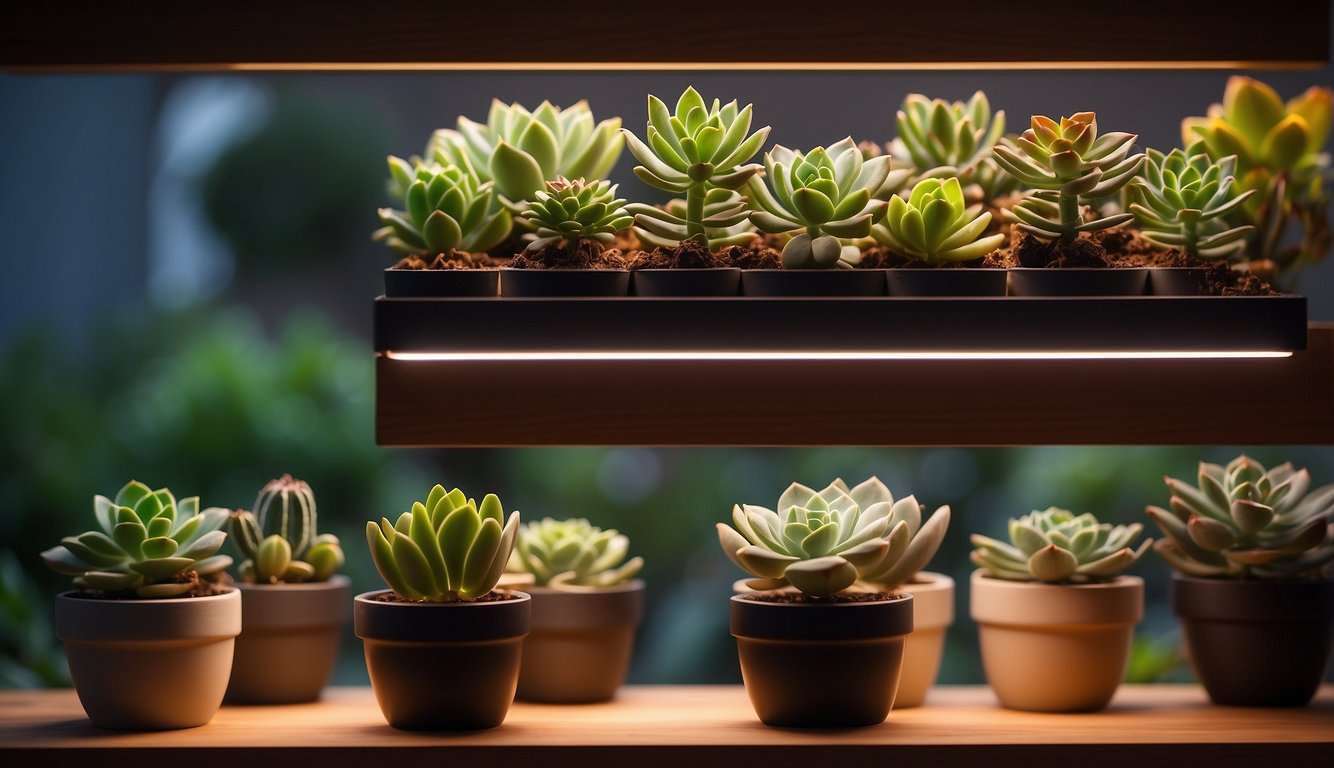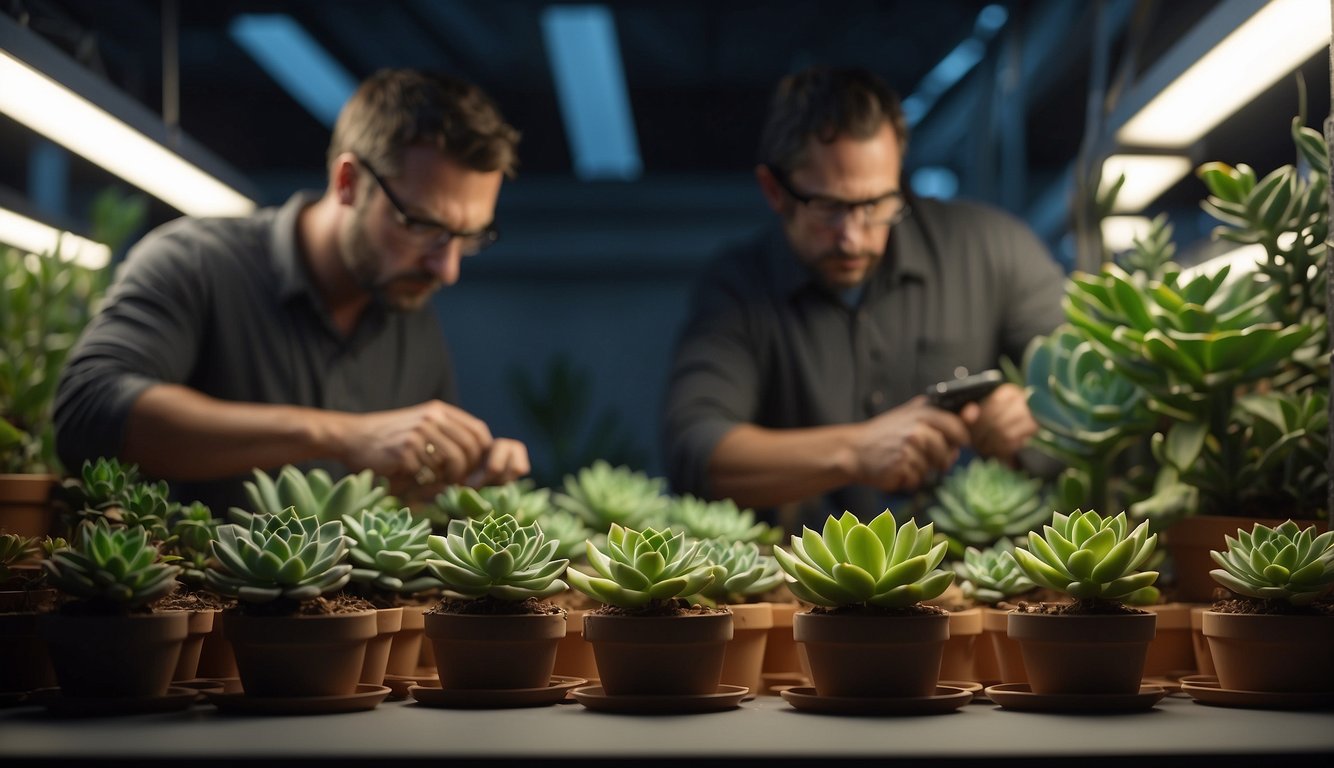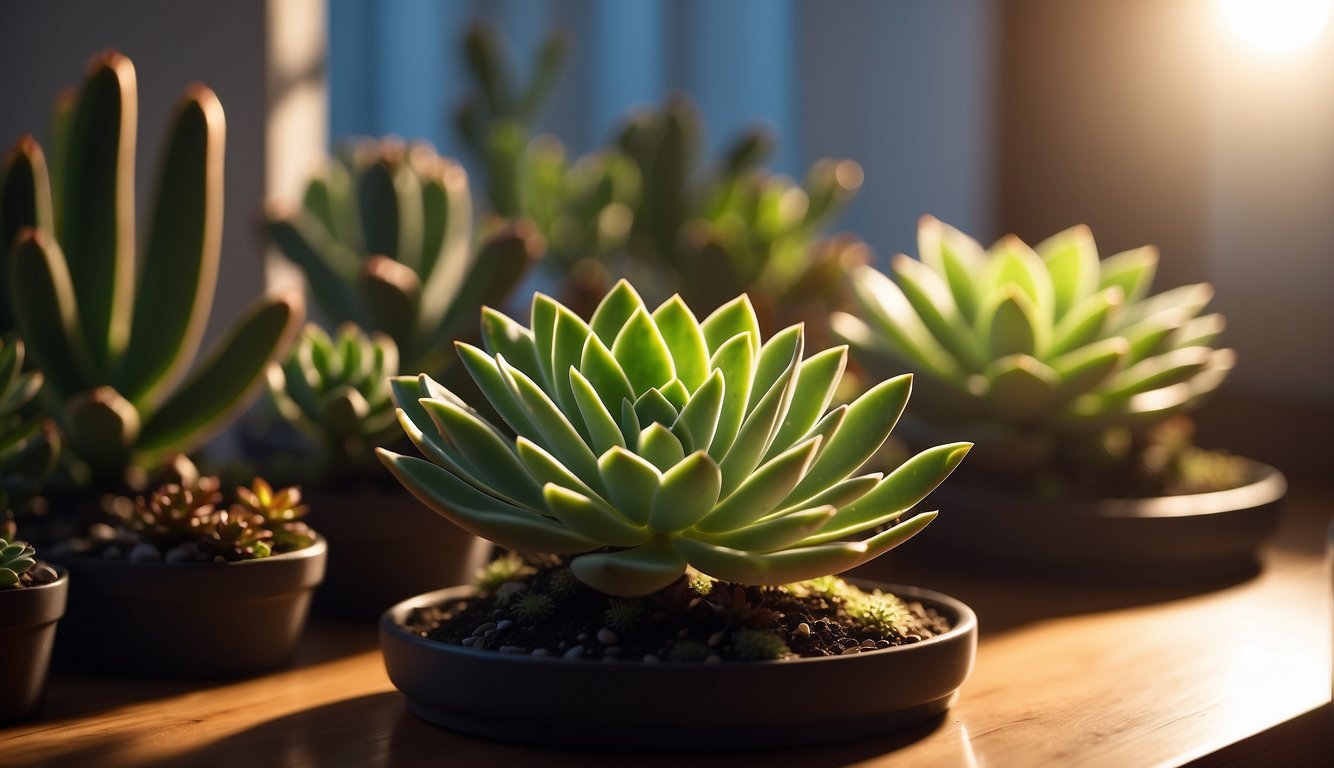TheHerbProf.com is a treasure trove of knowledge for those interested in natural healing and herbal remedies. The website is run by Paul Johnston MD. A naturopathic who has not only received extensive education in the field but also has personal experience in self-healing.
What are the best grow lights for succulents? As a succulent enthusiast, I know firsthand the importance of providing the right lighting conditions for indoor succulents. Since succulents require ample sunlight to thrive, it can be challenging to maintain their health indoors. That’s where grow lights come in handy.
In this article, I will share my top picks for the best grow lights for succulents. I will cover the different types of grow lights available, their benefits and drawbacks, and how to position them correctly to ensure your succulents receive the right amount of light. Whether you’re a seasoned succulent grower or just starting, this guide will help you choose the best grow lights for your indoor succulents.
Understanding Grow Lights for Succulents – Get The Best One Overall Here!

As a succulent enthusiast, I know how important it is to provide the right amount and quality of light for my plants. Grow lights can help supplement natural light and provide the necessary spectrum and intensity needed for photosynthesis. In this section, I will cover the basics of grow lights for succulents.
Photosynthesis and Light Requirements
Photosynthesis is the process by which plants convert light energy into chemical energy, which they use to grow and thrive. Succulents, like all plants, require light for photosynthesis. However, different plants have different light requirements, and succulents are no exception.
Succulents require bright, indirect light for optimal growth. Too much direct sunlight can scorch their leaves, while too little light can cause them to stretch and become leggy. Grow lights can help provide the right amount and quality of light for your succulents.
Spectrum and Wavelengths – Get The Best One Overall Here!
The spectrum and wavelengths of light are important factors to consider when choosing a grow light for your succulents. Different wavelengths of light affect plant growth and development in different ways. Blue light, for example, promotes vegetative growth, while red light promotes flowering and fruiting.
Full-spectrum grow lights provide a balanced spectrum of light that mimics natural sunlight. LED grow lights are a popular choice for indoor gardening because they are energy-efficient and can be customized to provide the right spectrum and intensity of light for your succulents.
Types of Grow Lights
There are several types of grow lights available, including LED, fluorescent, and CFL grow lights. LED grow lights are the most popular choice for indoor gardening because they are energy-efficient and can be customized to provide the right spectrum and intensity of light for your succulents. Fluorescent and CFL grow lights are also good options, but they are less energy-efficient and may not provide the same spectrum and intensity of light as LED grow lights.
In conclusion, understanding the basics of grow lights for succulents is essential for their optimal growth and health. By providing the right amount and quality of light, you can help your succulents thrive and flourish.
Choosing the Best Grow Lights for Succulents
As a succulent enthusiast, I understand the importance of providing adequate lighting for my plants to thrive. When it comes to choosing the best grow lights for succulents, there are several factors to consider. In this section, I will discuss the most popular types of grow lights and their advantages and disadvantages.
LED Grow Lights
LED grow lights have become increasingly popular in recent years due to their energy efficiency, long lifespan, and low heat output. These lights use less electricity than other types of grow lights, making them a more cost-effective option in the long run. LED grow lights also come in a variety of colors, allowing you to customize the spectrum of light your succulents receive. This is important because different colors of light can affect plant growth in different ways.
Fluorescent Grow Lights – Best Grow Lights for Succulents
Fluorescent grow lights are another popular option for growing succulents. They are more affordable than LED grow lights and provide a good balance of light output and energy efficiency. Compact fluorescent bulbs, or CFLs, are a type of fluorescent grow light that can fit into standard light fixtures. However, they do not last as long as LED grow lights and may need to be replaced more frequently.
Comparing Different Light Sources
When comparing different types of grow lights, there are a few key factors to consider: light output, color temperature, and wattage. Light output refers to the strength and intensity of the light being emitted from the grow light. For succulents, a grow light with a lumen rating between 2300 to 9300 per square foot is sufficient The Spruce. Color temperature refers to the color of the light being emitted, and can affect plant growth in different ways. For succulents, lights from 3,000K to 6,000K can support healthy growth Mountain Crest Gardens. Wattage refers to the amount of electricity the grow light uses, and can affect your energy bill. LED grow lights are the most energy-efficient option, followed by fluorescent grow lights.
In conclusion, when choosing the best grow lights for succulents, it is important to consider factors such as light output, color temperature, and wattage. LED grow lights are a popular and energy-efficient option, while fluorescent grow lights provide a good balance of light output and affordability. Ultimately, the best grow light for your succulents will depend on your specific needs and budget.
Factors to Consider When Buying Grow Lights

When buying grow lights for succulents, there are several factors to consider. These factors include intensity and lumens, heat emission, energy consumption, and cost. In this section, I will discuss each of these factors in detail to help you make an informed decision.
Intensity and Lumens – Best Grow Lights for Succulents
The intensity and lumens of a grow light refer to the strength and brightness of the light being emitted. The higher the lumen rating, the brighter the light. For succulents, a grow light with a lumen rating between 2300 to 9300 per square foot is sufficient. However, it is important to note that too much light can also be harmful to succulents, so it is important to strike a balance.
Heat Emission – Get The Best One Overall Here!
Heat emission is another important factor to consider when buying grow lights. Succulents are adapted to hot and dry environments, so they can tolerate higher temperatures than other plants. However, excessive heat can damage or kill your succulents. Therefore, it is important to choose a grow light that emits low heat.
Energy Consumption and Cost
Energy consumption and cost are also important factors to consider when buying grow lights. LED grow lights are the most energy-efficient and cost-effective option for growing succulents. They use less electricity and last longer than other types of grow lights. However, they can be more expensive upfront.
When choosing a grow light, it is important to consider your budget. While LED grow lights may be more expensive upfront, they can save you money in the long run by reducing your energy consumption and lasting longer than other types of grow lights.
In summary, when buying grow lights for succulents, it is important to consider the intensity and lumens, heat emission, energy consumption, and cost. LED grow lights are the most energy-efficient and cost-effective option for growing succulents, but it is important to strike a balance between cost and quality.
Setting Up Grow Lights for Succulents – Best Grow Lights for Succulents

When it comes to growing succulents indoors, setting up grow lights is essential. In this section, I will cover the key factors to consider when setting up grow lights for succulents.
Space and Location
Before setting up your grow lights, you need to consider the space and location where your succulents will be growing. Ideally, you want to choose a location that is close to a power source and has good ventilation. It’s also important to choose a location that is away from any drafts or temperature fluctuations.
Light Coverage and Distance – Get The Best One Overall Here!
When setting up your grow lights, you need to consider the light coverage and distance. The light coverage refers to the amount of space that the grow light can cover, while the distance refers to the distance between the grow light and the succulents.
For succulents, a grow light with a lumen rating between 2300 to 9300 per square foot is sufficient. The distance between the grow light and the succulents should be at least 6 inches. It’s important to adjust the distance based on the intensity of the light and the specific needs of your succulents.
Adjustable Features – Best Grow Lights for Succulents
When choosing a grow light for your succulents, it’s important to consider adjustable features such as dimmable and adjustable height. Dimmable grow lights allow you to adjust the intensity of the light, while adjustable height allows you to adjust the distance between the grow light and the succulents.
In addition to these features, it’s also important to consider the ventilation in your growing space. Make sure that your grow lights are not blocking any air vents and that there is adequate airflow around your succulents.
Overall, setting up grow lights for succulents requires careful consideration of space, location, light coverage, and adjustable features. By taking these factors into account, you can create the optimal growing environment for your succulents.
Grow Light Maintenance and Best Practices

As a succulent enthusiast, I know that the right grow light can make all the difference in the health and growth of your indoor plants. However, it’s important to remember that grow lights require regular care and maintenance to continue functioning optimally. Here are some best practices for maintaining your grow lights:
Regular Care and Maintenance
- Clean your grow lights regularly. Dust and debris can accumulate on the surface of your grow lights, which can reduce their effectiveness. Wipe down your grow lights with a soft cloth or sponge every few weeks to keep them clean.
- Check for damage. Regularly inspect your grow lights for any signs of damage, such as cracks or loose connections. If you notice any damage, replace the affected parts as soon as possible.
- Replace bulbs as needed. Grow light bulbs can lose their effectiveness over time, so it’s important to replace them periodically. Check the manufacturer’s recommendations for how often to replace your bulbs.
- Adjust the height of your grow lights. As your plants grow, you may need to adjust the height of your grow lights to ensure that they are getting the optimal amount of light. Keep an eye on your plants and adjust the height of your grow lights as needed.
Optimizing Light for Growth Stages – Best Grow Lights for Succulents
Different growth stages require different levels of light intensity and duration. Here are some tips for optimizing light for different growth stages:
- Vegetative growth: During the vegetative growth stage, succulents require bright light for 12-16 hours per day. A grow light with a lumen rating between 2300 to 9300 per square foot is sufficient.
- Flowering: During the flowering stage, succulents require bright light for 12-16 hours per day. A grow light with a lumen rating between 7000 to 10,000 per square foot is ideal.
- Fruiting: During the fruiting stage, succulents require bright light for 12-16 hours per day. A grow light with a lumen rating between 7000 to 10,000 per square foot is ideal.
- Succulent care: In general, succulents require bright light for 12-16 hours per day. However, it’s important to monitor your plants and adjust the light intensity and duration as needed.
- Indoor plants: Indoor plants require bright light to compensate for the lack of natural sunlight. A grow light with a lumen rating between 2300 to 9300 per square foot is sufficient for most indoor plants.
- Optimal growth: To promote optimal growth, it’s important to choose a grow light with the right color spectrum. Blue light promotes vegetative growth, while red light promotes flowering and fruiting. Many grow lights offer a full spectrum of colors to support all growth stages.
Common Issues and Troubleshooting – Get The Best One Overall Here!

As with any plants, succulents can face some common issues that can affect their growth and overall health. In this section, I will discuss some of the most common issues that can arise when growing succulents under grow lights and how to troubleshoot them.
Preventing Etiolation and Stretching – Best Grow Lights for Succulents
One of the most common issues that succulent growers face is etiolation, which is the stretching of the stem and leaves due to insufficient light. To prevent etiolation, it is important to provide your succulents with adequate light, which is typically around 6-8 hours of direct sunlight per day or using grow lights with sufficient light output. According to The Spruce, a grow light with a lumen rating between 2300 to 9300 per square foot is sufficient for succulents.
Another way to prevent etiolation is to avoid overwatering your succulents. Overwatering can cause the soil to become too moist, which can lead to root rot and weaken the plant. It is recommended to water your succulents only when the soil is completely dry.
Dealing with Heat Stress
Succulents are adapted to thrive in hot and dry conditions, but they can still face heat stress when grown under grow lights. Heat stress can cause the leaves to curl or become discolored, and in severe cases, it can lead to the death of the plant.
To prevent heat stress, it is important to provide your succulents with proper ventilation and air circulation. You can also adjust the distance between the grow light and the plants to regulate the temperature. According to The Succulent Eclectic, it is recommended to keep the grow light at least 6 inches away from the plants to prevent heat stress.
In addition, you can also use a fan to provide air circulation and reduce the temperature around the plants. It is also important to monitor the temperature and humidity levels in the grow room to ensure that they are within the optimal range for succulent growth.
By following these tips and troubleshooting common issues, you can ensure that your succulents thrive under grow lights and remain healthy and vibrant.
Advanced Topics in Grow Lighting

PAR and Nanometer Ratings – Best Grow Lights for Succulents
When it comes to grow lighting, two important terms to understand are PAR and nanometer ratings. PAR stands for photosynthetically active radiation, which is the portion of the light spectrum that plants use for photosynthesis. A grow light’s PAR rating tells you how much of this PAR light it emits. The higher the PAR rating, the more effective the light will be for plant growth.
Nanometer ratings refer to the specific wavelengths of light that a grow light emits. Different wavelengths of light have different effects on plant growth and development. For example, blue light (around 400-500 nm) is important for vegetative growth, while red light (around 600-700 nm) is important for flowering and fruiting. Some grow lights are designed to emit specific wavelengths of light to optimize plant growth at different stages of development.
Innovative Grow Light Technologies – Get The Best One Overall Here!
In recent years, there have been some exciting developments in grow light technology. LED grow lamps have become increasingly popular due to their energy efficiency and long lifespan. Cree is a well-known brand that produces high-quality LED grow lights with excellent PAR ratings. GooingTop LED grow lights are another popular option that offer a full spectrum of light for optimal plant growth.
Some LED grow lights, such as those produced by Ankace, also come with a control panel that allows you to adjust the light’s intensity and spectrum to suit your plants’ needs. This can be especially useful if you are growing a variety of different plants under the same light.
Overall, understanding PAR and nanometer ratings, as well as the latest grow light technologies, can help you choose the best grow light for your succulents.
Product Reviews and Recommendations

As a succulent enthusiast, I have researched and tested various grow lights to find the best options for my plants. In this section, I will share my top picks for LED grow lights for succulents and budget-friendly options.
Top LED Grow Lights for Succulents – Get The Best One Overall Here!
- Ankace 40W Grow Light: This is a versatile grow light that can be used for various stages of plant growth. It has a flexible gooseneck design, making it easy to adjust the light direction and angle. The Ankace 40W Grow Light emits a white light that is similar to natural sunlight, which is ideal for succulent growth. It also has a timer function, allowing you to set the light to turn off automatically after 3, 6, or 12 hours.
- Hydrofarm FLT44: This is a high-quality grow light that uses T5 fluorescent bulbs to provide full-spectrum light. The Hydrofarm FLT44 is perfect for those who want to grow a large number of succulents as it covers a wide area. It has a durable and sturdy construction, making it a long-lasting investment. The only downside is that it is more expensive than other options.
- GooingTop LED Grow Light: This is a budget-friendly option that still provides good results. The GooingTop LED Grow Light has a full-spectrum design that mimics natural sunlight, promoting healthy succulent growth. It has a clip-on design, making it easy to attach to various surfaces. The only drawback is that it doesn’t have a timer function.
Budget-Friendly Options – Get The Best One Overall Here!
- Roleadro LED Grow Light: This is an affordable option that provides good results. The Roleadro LED Grow Light has a full-spectrum design that promotes plant growth. It has a sturdy construction and a built-in cooling system to prevent overheating. The only downside is that it doesn’t cover a large area.
- DuroLux 2-Pack T5 HO Grow Light: This is a cost-effective option for those who want to grow multiple succulents. The DuroLux 2-Pack T5 HO Grow Light uses fluorescent bulbs to provide full-spectrum light. It has a durable and lightweight construction, making it easy to install. However, it doesn’t have a timer function.
When shopping for a grow light, it is important to consider your budget, the size of your succulent collection, and the type of light that best suits your plants. I hope these product reviews and recommendations help you make an informed decision when buying a grow light for your succulents.
The Bright Connection: Best Grow Lights for Succulents and The Herb Prof
Let’s shed some light on best grow lights for succulents and its connection to our herbal paradise, theherbprof.com. Ready to glow?
Firstly, choosing the best grow lights is a task of precision and knowledge. It’s about finding the perfect light for our succulent buddies. Sounds familiar? That’s because theherbprof.com helps you find the perfect knowledge in the herbal world!
Secondly, both grow lights and theherbprof.com are about nurturing growth. Just like a succulent thrives under the right light, theherbprof.com helps your herbal knowledge thrive with accurate information.
Lastly, they both aim to enrich our lives. Succulents add a touch of green to our homes, while theherbprof.com adds a touch of wisdom to our minds with herbal knowledge.
So, there you have it! Best grow lights for succulents and theherbprof.com are a bright pair indeed. They both symbolize precision, nurturing growth, and enrichment. Now, isn’t that a bright piece of information to share at your next garden party? Keep growing, folks!
References – Best Grow Lights for Succulents
Little Herb Encyclopedia, by Jack Ritchason; N.D., Woodland Publishing Incorporated, 1995
The Ultimate Healing System, Course Manual, Copyright 1985, Don Lepore
Planetary Herbology, Michael Tierra, C.A., N.D., Lotus Press, 1988
Handbook of Medicinal Herbs, by James A. Duke, Pub. CRP Second Edition 2007
The Complete Medicinal Herbal, by Penelope Ody, Published by Dorling Kindersley
Check the Following Articles!
Pepper Seeds Not Sprouting? All You Need To Know!
Cactus Scale Treatment: How to Get Rid of Scale Insects
Watering Mint Indoors: Tips for Healthy Growth
Frequently Asked Questions – Best Grow Lights for Succulents

What color spectrum is most beneficial for succulent growth under artificial lighting?
The optimal color spectrum for succulent growth under artificial lighting is a full spectrum that includes both blue and red wavelengths. Blue light promotes vegetative growth, while red light encourages flowering and fruiting. A balanced combination of blue and red light ensures healthy succulent growth and development.
How many hours per day should succulents be exposed to grow lights for optimal health?
Succulents require at least 6 to 8 hours of exposure to grow lights per day for optimal health. However, some succulent varieties may require up to 12 hours of exposure to grow lights per day, depending on their specific light requirements. It is important to monitor the growth and health of your succulents and adjust the lighting accordingly.
What wattage is recommended for grow lights when cultivating succulents indoors?
The recommended wattage for grow lights when cultivating succulents indoors depends on the size of your growing area. As a general rule, you should aim for a minimum of 20 watts per square foot of growing space. However, it is important to note that wattage alone does not determine the quality of light produced. Lumens per watt is a more useful metric for comparing the energy efficiency of grow lights.
Are LED grow lights a suitable option for maintaining healthy succulents, and why?
Yes, LED grow lights are a suitable option for maintaining healthy succulents. LED grow lights are energy-efficient and produce less heat than traditional grow lights, making them a safer and more cost-effective option for indoor gardening. Additionally, LED grow lights can be customized to provide the optimal color spectrum for succulent growth.
Can succulents suffer from light burn with LED grow lights, and how can it be prevented?
Yes, succulents can suffer from light burn with LED grow lights if they are exposed to too much light for an extended period. To prevent light burn, it is important to monitor the distance between the succulents and the LED grow lights and adjust the height of the lights accordingly. Additionally, you can reduce the intensity of the light by using a dimmer switch or by increasing the distance between the plants and the lights.
What are the differences between red and blue grow lights, and which is more suitable for succulent plants?
Red grow lights promote flowering and fruiting, while blue grow lights promote vegetative growth. Both red and blue grow lights are important for the healthy growth and development of succulent plants. A balanced combination of red and blue grow lights is recommended for optimal succulent growth.


